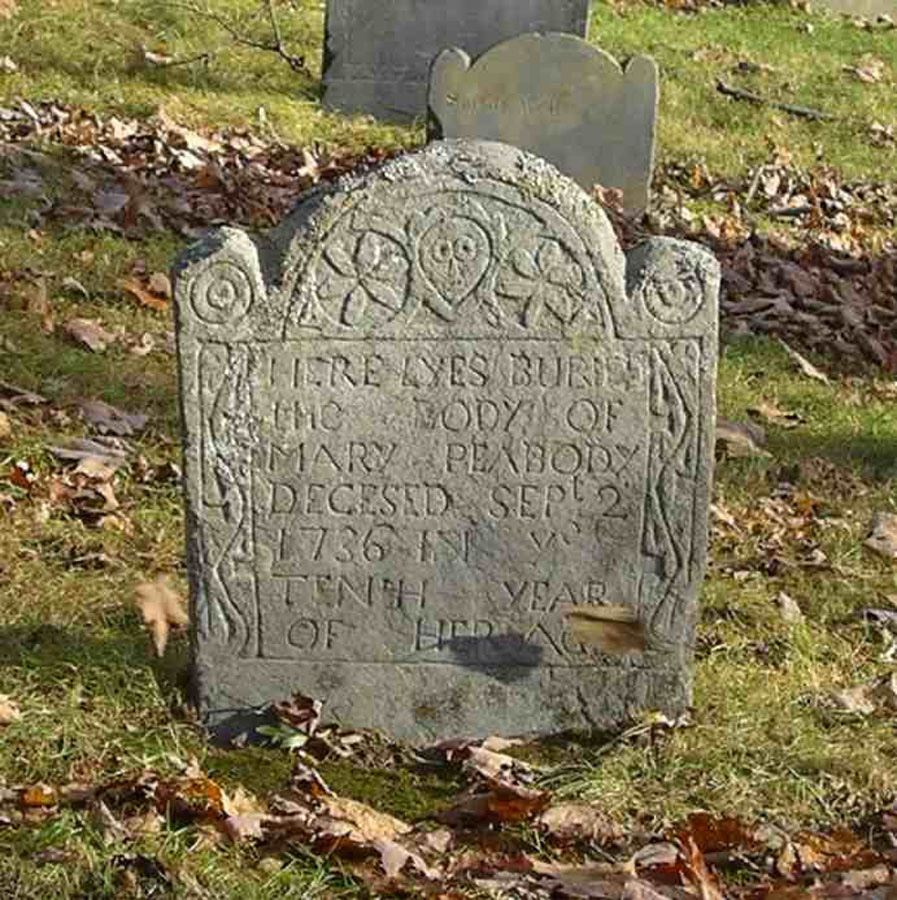
In 1736, scarlet fever was present in Boston and neighboring towns, but while the scarlet fever epidemic was spreading out from Boston, the diphtheria epidemic was descending from the north, and in Essex county they traveled along the Old Bay Road at the very same time, but in opposite directions. An epidemic that ensued in Ipswich was more similar to the epidemic in New Hampshire and other northern towns.

An epidemic of “throat distemper” raged in New England between 1735 and 1740. The contagion struck first in New Hampshire, killing almost 1% of the population. The epidemic spread south through the Massachusetts Bay Colonies, and eventually into Connecticut. By the time it had run its course, 5000 people had died, and more than 75% of the deaths where children. In Hampton Falls as of July 16, 1736 there had been 210 deaths, 160 under the age of ten. The epidemic affected Kensington a decade later, where 250 child victims of “throat distemper” died between 1744 and 1779.

Ernest Caulfield described the path of the disease south into Massachusetts in his “A History of the Terrible Epidemic, Vulgarly called the Throat Distemper, as it Occurred in his Majesty’s New England Colonies between 1735 and 1740” and “The Throat Distemper of 1735-1740 Part II.” (excerpts below)
“It has long been known that there was an epidemic of some disease in Kingston, New Hampshire, in 1735, but…this was merely a small part of a greater epidemic which involved most of the inhabited regions of New England and caused great loss of life wherever it appeared. In some of the towns nearly half of all the children died and at times it was feared that the disease would actually destroy the colonies.
“This strange “Plague in the Throat” was not like any disease with which they were familiar. They knew that whooping-cough and measles could spread among children, but never had any such mortality accompanied a childhood epidemic.

“Late in the summer of 1735, the disease invaded the northern part of Massachusetts…carried into Massachusetts by countless travelers going to many different towns. (*Maine was a part of Massachusetts until 1820). Most of the old towns between Casco Bay and Boston were connected by a road (the Old Bay Road) which ran roughly parallel to the coast and far enough inland to avoid the many small inlets, marsh lands, and sandy dunes.

“A few weeks after the Kingston outbreak, the disease invaded Kittery and Hampton Falls, two important trading centers along this road. From Kittery the infection was carried northward into Maine and from Hampton Falls southward across disputed territory into the Province of Massachusetts Bay. Amesbury and Salisbury were soon involved, and by September the epidemic had crossed the Merrimack River and like an invading army concentrated its forces at Newbury before it started down the old Bay Path towards Boston.

“Byfield, a parish of about eighty-five families in the southwest part of Newbury, also became involved in the autumn of 1735, and within a year there were over a hundred deaths, which was said to have been more than a seventh of the total population.
“For a time it seemed that Rowley, a few miles south of Newbury on the Bay Path, would escape a serious epidemic. There were occasional multiple deaths during the winter of 1735-36, mostly in that part of the town that was close to Byfield, and by spring it was supposed that the distemper had abated throughout the “Eastward.”
“This was only an apparent calm, for on the first day of summer, two-year-old John Plumer, of the second parish, died, “the first child that died in this parish of ye sore sickness of which great numbers have died in Neighbour Parishes,” and for the next six or eight months the epidemic spread with its usual violence. In the second parish, where there had been less than eight deaths annually, forty-six children died, and it has been estimated that in Rowley and neighboring parishes, two hundred, or one-eighth of the total population, died during the first year of the sickness.
“There is good reason to believe that the disease in Newbury, Byfield, and Rowley was diphtheria, or the same that was present in New Hampshire. The very high death-rate and the frequency of multiple deaths are the two outstanding characteristics that differentiate it from scarlet fever, at least from the type of scarlet fever that was prevalent at that time.
“In Ipswich, however, the history of the epidemic is somewhat confusing. In April 1736, the Boston News-Letter reported: ‘Tis said, the Distemper is abated at the Eastward; . . . ‘Tis also said, that several have lately died of a Scarlet Fever at Ipswich and other Places.”
The Ipswich Vital Records and Felt’s History of Ipswich, Essex, and Hamilton show two or more deaths in several families, including the Abbe, Appleton, Baker, Bennet, Boardman, Brown, Burnam, Choate, Fuller, Gibson, Hart, Heard, Jackson, Jewett, Kimball, Knowlton, Lull, Neland, Pierce, Pottar, Safford, Shatswell, Sherwin, Smith, Treadwell, Trucker, and Webber families.
- Michael Farley lost five children in April, 1736, four of them in one week.
- John Abbott, a neighbor, also lost eight children about the same time
- December 7, 1736: Mark How, and John Abbott his neighbor, had each lately lost eight children by this sickness.
- January 23, 1735: Nathaniel Cross, of the Hamlet, had lost seven and all his children within about a month with the throat distemper.
- March 21, 1738: John Treadwell has three children buried in one grave, and one more before, within five days, with the same disease.
From the Publications of the Ipswich Historical Society we read, “In November 1736, a deadly distemper invaded the home of Mark and Hephzibah Howe in Linebrook. The pitiful record of their sore affliction remains on a page of an ancient account book that must have been wet with tears. Their house was left desolate, not a child surviving. All the children of Mark and Hephzibah Howe died and were buried in the old Leslie Road Burying Ground.” Town records state that they died of “cancre quinsy,” an eighteenth century term for laryngeal obstruction.”
- November 5, 1736: Lucy died aged 9 years
- November 15, 1736: Mary died aged 7 years
- November 18, 1736: Hannah 13 years and Aaron 5 years died
- November 21, 1736 Abijah 1 year died
- November 21, 1736: Mark 2 years died Nov 24 They all died with the “cancre quinsey”
- November 25, 1736: Moses died in ye 11 year of his age 28
- November, 1736 Love died aged 12 years
Thomas Franklin Waters wrote that Ipswich Village, just below Rowley on the Old Bay Road suffered greatly.
“In the year of 1736, sorrow settled heavily upon the household of Nehemiah Jewett. No doubt the deadly throat distemper was the cause.
- Patience, eighteen years old, died on May first
- Mary the day after
- Mehitable, twenty-five, her mother’s companion, the staff and stay of the family, followed on May 10th
- Jane on the eleventh
- On the second of June, twelve-year-old Joanna.”
“On Paradise Rd. was the home of John Boardman and his wife Abigail Choate. On one black and awful day, November 3, 1736, three children died. Lucy, four, Mary seven, and Sarah, nine years old; and on the following day, baby Francis, fifteen months old, was taken. The older children, John, fifteen, Abigail, fourteen and Thomas, twelve, were spared.”
Dr. John Manning of Ipswich is credited with making vaccinations available to the general public. After successfully immunizing his family against smallpox in 1799, he distributed the vaccine without payment to other practitioners, purposefully breaking the monopoly held by Professor Benjamin Waterhouse of Harvard.
Since the introduction of effective diphtheria immunization in the 1920’s, the disease is now all but eliminated in the United States and other countries that vaccinate widely. There is no vaccine for scarlet fever, but the since the discovery of antibiotics, the disease is now treatable.
Originally published by Historic Ipswich, republished under fair use for educational, non-commercial purposes.







